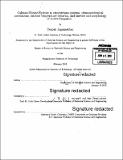Calcium-Silicate-Hydrate in cementitious systems : chemomechanical correlations, extreme temperature behavior, and kinetics and morphology of in-situ formation
Author(s)
Jagannathan, Deepak
DownloadFull printable version (15.90Mb)
Other Contributors
Massachusetts Institute of Technology. Department of Materials Science and Engineering.
Advisor
Krystyn J. Van Vliet.
Terms of use
Metadata
Show full item recordAbstract
Concrete, the second most used material on the planet, is a multi-scale heterogeneous material. A fundamental component known as Calcium-Silicate-Hydrate which forms from the reaction between cement and water is the binding phase in concrete. Curiously, this is the least understood component of concrete because of its porous amorphous structure. Further, beyond mere scientific curiosity, cementS̆s industry large carbon footprint due to its volume of usage sets up a practical context to seek improvements in concrete performance and equip concrete with additional functionalities. It is our contention that we can better understand the least known and crucial component of concrete, Calcium-Silicate-Hydrate, to inform the design of next generation of high performance concrete. With this broad theme, this thesis presents three different aspects of properties of Calcium Silicate Hydrate: chemomechanical correlations, behavior under extreme temperature and pressures, and kinetics and nanostructure of in-situ formation. Calcium Silicate Hydrate (C-S-H) formed in-situ in concrete is believed to have a layered structure with silicate chains similar to crystal structures of Tobermorite and Jennite. Its chemical composition, characterized by Ca/Si ratio, must therefore influence its silicate chain structure and thus its mechanical properties. We explore the correlation between CS- H composition and its mechanical properties. By varying chemical composition of cement clinkers and supplementary cementitious materials, water/cement ratios, and hydration temperatures, we prepare cement pastes with different C-S-H of different C/S ratios. We use nanoindentation and X-ray spectroscopy to respectively measure the mechanical properties and composition of C-S-H. We then study the mechanical performance of C-S-H at elevated temperatures. This is relevant in the design of infrastructure that can sustain extreme events such as blasts and high velocity impacts. As a starting point for concrete that would enable such infrastructure, we use ultra high performance concrete (UHPC). We use nanoindentation and X-ray spectroscopy to respectively measure mechanical properties and composition of individual components of UHPC. We compare the composition and properties of C-S-H found in UHPC to that found in ordinary cement pastes (OPC). Our grid nanoindentation experiments also reveal an artifacts created by the incorporation of steel fiber reinforcements in UHPC. We find that steel fiber reinforcements disrupt the perfect packing of constituent materials in UHPC to create capillary porosity at microscale. Further, we study the mechanical properties of C-S-H in concrete specimens subjected to high temperatures of 400°C and 1000°C. As a product of the reaction between cement and water, the properties of C-S-H are ultimately controlled by the reaction. To obtain quantitative kinetics, we use time-lapse optical microscopy to study hydration of micron sized monoclinic C₃S particles with in droplets of water of 50 [mu]m. Using Raman spectroscopy, we characterize the hydration product growing inside these droplets.
Description
Thesis: S.M., Massachusetts Institute of Technology, Department of Materials Science and Engineering, 2013. Cataloged from PDF version of thesis. Includes bibliographical references (pages 96-102).
Date issued
2013Department
Massachusetts Institute of Technology. Department of Materials Science and EngineeringPublisher
Massachusetts Institute of Technology
Keywords
Materials Science and Engineering.